Posted on Sunday 30 August 2009
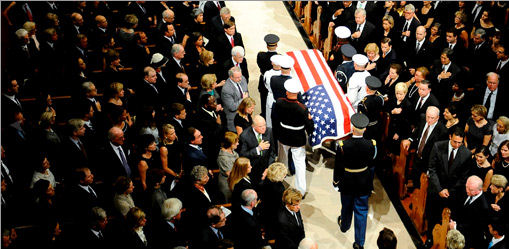

How a Detainee Became An Asset
Sept. 11 Plotter Cooperated After Waterboarding
By Peter Finn, Joby Warrick and Julie Tate
Washington Post
August 29, 2009After enduring the CIA’s harshest interrogation methods and spending more than a year in the agency’s secret prisons, Khalid Sheik Mohammed stood before U.S. intelligence officers in a makeshift lecture hall, leading what they called "terrorist tutorials." In 2005 and 2006, the bearded, pudgy man who calls himself the mastermind of the Sept. 11, 2001, attacks discussed a wide variety of subjects, including Greek philosophy and al-Qaeda dogma. In one instance, he scolded a listener for poor note-taking and his inability to recall details of an earlier lecture.
Speaking in English, Mohammed "seemed to relish the opportunity, sometimes for hours on end, to discuss the inner workings of al-Qaeda and the group’s plans, ideology and operatives," said one of two sources who described the sessions, speaking on the condition of anonymity because much information about detainee confinement remains classified. "He’d even use a chalkboard at times."
These scenes provide previously unpublicized details about the transformation of the man known to U.S. officials as KSM from an avowed and truculent enemy of the United States into what the CIA called its "preeminent source" on al-Qaeda. This reversal occurred after Mohammed was subjected to simulated drowning and prolonged sleep deprivation, among other harsh interrogation techniques.
"KSM, an accomplished resistor, provided only a few intelligence reports prior to the use of the waterboard, and analysis of that information revealed that much of it was outdated, inaccurate or incomplete," according to newly unclassified portions of a 2004 report by the CIA’s then-inspector general released Monday by the Justice Department.
The debate over the effectiveness of subjecting detainees to psychological and physical pressure is in some ways irresolvable, because it is impossible to know whether less coercive methods would have achieved the same result. But for defenders of waterboarding, the evidence is clear: Mohammed cooperated, and to an extraordinary extent, only when his spirit was broken in the month after his capture March 1, 2003, as the inspector general’s report and other documents released this week indicate.
Over a few weeks, he was subjected to an escalating series of coercive methods, culminating in 7 1/2 days of sleep deprivation, while diapered and shackled, and 183 instances of waterboarding. After the month-long torment, he was never waterboarded again. "What do you think changed KSM’s mind?" one former senior intelligence official said this week after being asked about the effect of waterboarding. "Of course it began with that." Mohammed, in statements to the International Committee of the Red Cross, said some of the information he provided was untrue.
"During the harshest period of my interrogation I gave a lot of false information in order to satisfy what I believed the interrogators wished to hear in order to make the ill-treatment stop. I later told interrogators that their methods were stupid and counterproductive. I’m sure that the false information I was forced to invent in order to make the ill-treatment stop wasted a lot of their time," he said…

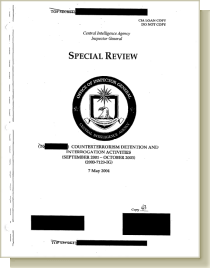 Well, I finally read the recently released version of the CIA OIG Report front to back [COUNTERTERRORISM DETENTION AND INTERROGATION ACTIVITIES (SEPTEMBER 2001- OCTOBER 2003)]. I was impressed with its thoroughness, and with the conduct of most of the CIA Officers who were involved in the Program. While I hated what they did, considering that they were placed in an impossible situation, I thought they showed a lot of professionalism in their implementation of their assigned task – poorly designed and illegal as it was. There were instances where some of them stepped over the line, but that would be expected in such a confusing environment.
Well, I finally read the recently released version of the CIA OIG Report front to back [COUNTERTERRORISM DETENTION AND INTERROGATION ACTIVITIES (SEPTEMBER 2001- OCTOBER 2003)]. I was impressed with its thoroughness, and with the conduct of most of the CIA Officers who were involved in the Program. While I hated what they did, considering that they were placed in an impossible situation, I thought they showed a lot of professionalism in their implementation of their assigned task – poorly designed and illegal as it was. There were instances where some of them stepped over the line, but that would be expected in such a confusing environment.I was bothered by two things. The first was the naive attempts by the DoJ OLC to rationalize that the things we were doing weren’t "Torture," or that we weren’t bound by International Agreements or our own laws for a variety of contrived reasons. Likewise, the CIA seemed to believe that so long as it followed its set of bureaucratic guidelines and had adequate documentation, the program was within the law. In both cases, intellectualized arguments and procedures replaced basic common sense – obvious to anyone reading this report.
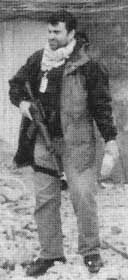 But I was disappointed in the Report for its absence of any real analysis of the overall approach itself. We have been repeatedly reminded that, after 9/11, we were desperate to know al Qaeda’s Plans, and that has been either the stated or implied justification for this over-the-line program’s existence – something like "You got to understand. We’ve got to find out what al Qaeda is up to to protect the American people!" All of us know that, and at some level agree. But is regression to some slightly sanitized ancient torture dungeon the way to achieve that goal? I found nothing in this report that addressed this question directly. In fact, with the exception of the testimony of FBI Agent Ali Soufan in a Congressional Hearing, interviews, and an op-ed, nobody seems to want to address this question.
But I was disappointed in the Report for its absence of any real analysis of the overall approach itself. We have been repeatedly reminded that, after 9/11, we were desperate to know al Qaeda’s Plans, and that has been either the stated or implied justification for this over-the-line program’s existence – something like "You got to understand. We’ve got to find out what al Qaeda is up to to protect the American people!" All of us know that, and at some level agree. But is regression to some slightly sanitized ancient torture dungeon the way to achieve that goal? I found nothing in this report that addressed this question directly. In fact, with the exception of the testimony of FBI Agent Ali Soufan in a Congressional Hearing, interviews, and an op-ed, nobody seems to want to address this question.
I haven’t given it a lot of thought myself, but I’ve teased lawyer friends as follows: "We Psychiatrists and Psychoanalysts try to figure out a patient’s psyche and psychological glitches so we can help them find a more adaptive way to live. You guys do the same thing, except you use your insights to discredit them." It’s a bit too hostile, because the really good lawyers are using their psychological skills to get at the truth too. I’d like to have a shot at saying what I think about approaching the "high value detainees" – realizing full well that my musings are just the thoughts of a retired shrink with zero experience with such people.
We all know what’s wrong with Torture. People will tell you anything to get you to stop. Most of the information is misinformation. Since the interrogator doesn’t know when you’re lying and when you just don’t know anything, they’re not going to stop until you tell them something. So you tell them something and they send it back to a jillion analysts who cross-reference it with other information and decide the likelihood that it’s true. We seem to be better at evaluating the truth of information than knowing how to get it.
Torture is a strategy. It’s a way of forcing people into a situation that might make them behave in the way you want them to behave, a way of shaping behavior. Parents try strategies all the time. It’s an inauthentic way of communicating. If I’m dealing with you strategically, I’m an actor. What’s happening inside of me and what you’re seeing are different things. Psychotherapists try such things all the time [particularly young ones]. Unfortunately, their clients are people who were raised by "strategizing" parents and are impervious to such "techniques" – worse, they’re put off and often move on to someone else. In fact, children raised by indirect, strategizing parents are usually paranoid, always looking for the "trick" behind the words.
In war, the soldier is asked to reverse his morality. We spend our lives being taught not to hurt or kill others, then we go off to war where the goal is to hurt or kill others. How do we do that? Not easily. Many of the cases of PTSD I personally saw coming out of the Viet Nam War were not the result of something that was done to the soldier, or something he saw. It was from something he did. The trauma is awakening to the "sameness," the humanity of the person you killed or hurt. – a mother’s son, wife’s husband, a child’s father. The soldier has to depersonify the enemy soldier to kill him. And the soldier has to realize that the enemy soldier has depersonified him. It’s an abnormal interpersonal state – killing others. In fact, the "otherness" is what makes it possible. So soldiers talk about ""Japs," "Yanks," "Gooks," "Towel-Heads" – depersonifying terms. They might as well call the enemy "Trolls," or "Evil Step-mothers," or "Orks" [in my mom’s stories, they were the "Wicked Wiggly-Goolies"]. Continuing the depersonification motif of war hardly seems like the right way to approach prisoners. They just keep fighting.
I’ll bet that Ali Soufan is a very authentic guy, a straight shooter. I’d also bet that he would have made a fine psychotherapist. What was his technique? He was authentic and did not let the detainee depersonify him. He treated the detainee like another human being. He confronted the detainee with his simplified ideas and lies. He argued religion, politics, absurd rationalizations. He was a human being encountering another human being head on. In technical terms, he was not being what the detainee had been trained to expect – neither an "other" nor a "strategizer." He was deliberately inducing cognitive dissonance – confronting the detainee with false simplifications of the "enemy." I’ll bet Soufan is a "natural" – someone who just knew when the other person was lying or telling the truth, who just knew when the detainee was speaking authentically or hiding behind a mask.
 Our CIA Interrogation Program was being directed by total Rookies: Dick Cheney, David Addington, John Yoo, George Tenet, a couple of military psychologists [Jim Mitchell and Bruce Jessen]. They are not experts, none of them. Our Interrogators acted like monsters, treated the detainees like animals, and used strategies concocted from ancient history and psychology books with no experiential basis. The results were nil. No big surprise. They sent the seasoned Interrogators like Ali Souffan and Steve Gaudin home and kept at it with their Rookies.
Our CIA Interrogation Program was being directed by total Rookies: Dick Cheney, David Addington, John Yoo, George Tenet, a couple of military psychologists [Jim Mitchell and Bruce Jessen]. They are not experts, none of them. Our Interrogators acted like monsters, treated the detainees like animals, and used strategies concocted from ancient history and psychology books with no experiential basis. The results were nil. No big surprise. They sent the seasoned Interrogators like Ali Souffan and Steve Gaudin home and kept at it with their Rookies.
This document is part of the document release last Monday. It’s a description of the process used for prisoners taken to CIA Black Sites overseas [rendition] prepared by the CIA for Dan Levin in the Justice Department’s Office of Legal Counsel [12/30/2004]. I won’t quote it as it’s fa airly straightforward twenty pages written in a clinical detached manner. It is essentially a torture manual. There’s really nothing else to call it.
The HVD [high value detainee] was flown to an overseas flight in a state of sensory deprivation [hooded with earcovers]. From arrival they were bombarded with loud white noise and bright lights, stripped naked, shackled upright to cause sleep deprivation, and subjected to "dietary manipulation." Thereafter, they were interrogated using the coercive methods we’ve read about – various kinds of slaps, slammed into walls, doused with water. Sleep deprivation lasted up to 180 hours. The process went on for 30 days [or sometimes longer].
Like I said, it’s a torture manual – laid out as if it’s some kind of medical procedure. It’s monsterous at the least, made all the more bizarre by the recurrent reassurances that "we do not torture." If you haven’t yet realized that we did torture as a routine process for high value detainees, just read this 19 page document. You’ll need nothing else to convince you.
Why were these sites on foreign soil? I guess they thought that they were exploiting a loophole – something like "we don’t torture in America" – as if moving the prisoners to another country to be tortured [by Americans] made it okay. They included physicians and psychologists in the process, as if that inclusion somehow legitimized what they were doing. They imposed limits like no more that 180 hours of sleep deprivation or no more than 30 days without reauthorization as if these limits somehow insured that the prisoner wouldn’t be something [killed, maybe?]. They limited the volume of the white noise to 79 dB as if this limit protected against something [permanent deafness?]. But most of all, when they were forced to admit they were doing these things, they talked as if this wasn’t torture.

1. The worst is yet to come. Yesterday the CIA released a fresh copy of the report with roughly half of the “case study” discussion now unmasked. But context and placement suggest that the material that remains concealed contains some of the worst discussion of abuse in the report. The heavy redactions start around page 25, and the redactions cover discussion of the origins of the program and the approval process, as well as the discussion of specific prisoners, notably Abu Zubaydah, Abd al-Rahim al-Nashiri, and Khalid Shaikh Mohammad. Although cases in which the guidelines provided by the Justice Department were exceeded have been discussed, it’s likely the case that the still blacked-out passages cover instances where Justice gave a green light but the conduct was so gruesome that CIA wants to keep it under wraps. That means we haven’t heard the last of the Helgerson report, and further disclosures are likely.2. Opposition from within…3. George Tenet and Michael Hayden misled the public…4. All trails lead to the Vice President’s office…5. Functioning of black sites…6. The CIA’s waltz with Justice…7. The “prior investigation” canard…
Ex-CIA official John Helgerson says agents lost control after torture go-ahead
TimesOnline
by Tim Reid
August 26, 2009The author of a scathing report on CIA interrogations during the Bush era has claimed that certain operatives lost control once they had been authorized to use “enhanced” interrogation techniques such as waterboarding.
John Helgerson, the former inspector-general of the CIA, also told The Times that the Obama Administration had cut key passages of his report out of the released version, a decision he found “puzzling”…
1. The worst is yet to come…2. Opposition from within…3. George Tenet and Michael Hayden misled the public…4. All trails lead to the Vice President’s office…5. Functioning of black sites…6. The CIA’s waltz with Justice. The Bush Administration claimed that Justice gave legal advice to the CIA and that the CIA followed and applied it. But the IG report reveals a strikingly different relationship. As the OLC memos were written, there was a sort of waltz between CIA and Justice lawyers in which different hypotheticals were offered up in solicitation of opinions—something on the order of “If we told you we did x, what would you say about it?” This suggests the OLC memos were effectively negotiated. It also appears that CIA requested a number of after-the-fact variations to protect practices that clearly exceeded guidance. Why does this matter? It undermines the ability of CIA employees and contractors to “rely in good faith” on the OLC memos, because it shows that OLC wasn’t really giving legal advice. Instead it was issuing “get out of jail free” cards. A good example comes with waterboarding: “With respect to two detainees at those sites, the use and frequency of one EIT, the waterboard, went beyond the projected use of the technique as originally described to DoJ. The Agency, on 29 July 2003, secured oral DoJ concurrence that certain deviations are not significant for the purposes of DoJ’s legal opinions.”7. The “prior investigation” canard…
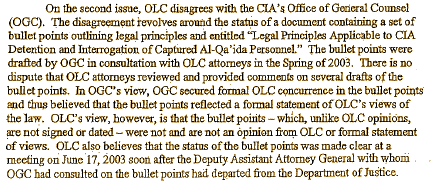

Not hard to guess, is it? This information is beginning to make an "actionable" case of conspiracy to evade to law, involving [at the least] Dick Cheney [VP], David Addington [VP’s Counsel], John Yoo [DoJ, OLC], and Scott Muller [CIA’s Counsel]…
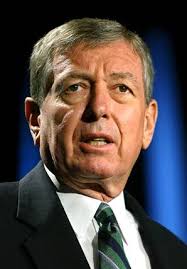 Note: Once again, the hero in the piece is Attorney General John Ashcroft [as was the case with his appointing Jim Comey and refusing to sign the Surveillance approval in the hospital]. This time, he blocked the appointment of John Yoo to head the OLC, and insisted on Jack Goldsmith. That meant that John Yoo headed back to California, and Goldsmith began to deconstruct the Torture Memos and the "Legal Principles" document. Whether it was his own intrinsic morality or his listening to Comey and Goldsmith, he ended up doing the right thing. In the case of John Ashcroft, in the end, honesty trumped ideology and loyalty. I doubt that I would like him if we got into a discussion of politics [and vica versa], but I certainly respect what he did as an Attorney General when the chips were down. Note: Once again, the hero in the piece is Attorney General John Ashcroft [as was the case with his appointing Jim Comey and refusing to sign the Surveillance approval in the hospital]. This time, he blocked the appointment of John Yoo to head the OLC, and insisted on Jack Goldsmith. That meant that John Yoo headed back to California, and Goldsmith began to deconstruct the Torture Memos and the "Legal Principles" document. Whether it was his own intrinsic morality or his listening to Comey and Goldsmith, he ended up doing the right thing. In the case of John Ashcroft, in the end, honesty trumped ideology and loyalty. I doubt that I would like him if we got into a discussion of politics [and vica versa], but I certainly respect what he did as an Attorney General when the chips were down. |
1. The worst is yet to come…2. Opposition from within…3. George Tenet and Michael Hayden misled the public…4. All trails lead to the Vice President’s office. At several points, redactions begin just when the discussion is headed toward the supervision or direction of the program and context suggests that some figure far up the Washington food chain is intervening. Moreover, as Jane Mayer recounts in Dark Side, Helgerson’s report was shut down when he was summoned, twice, to meet with Dick Cheney, who insisted that the report be stopped. Cheney had good reason to be concerned. This report shows that the vice president intervened directly in the process and ensured that the program was implemented. The OPR report likewise shows Cheney’s office commissioning the torture memos and carefully supervising the process. It is increasingly clear that torture was Dick Cheney’s special project and that he was personally and deeply involved in it. And the CIA report has some amazing nuggets that show Cheney’s hand. In 2003, after Jay Bybee departed OLC, Cheney struggled to have John Yoo installed as his successor, but ultimately John Ashcroft’s candidate, Jack Goldsmith, prevailed. Goldsmith quickly backtracked on the torture authorizations that Yoo and Bybee gave. The result? The CIA stopped taking its cue from OLC and instead turned to the White House for guidance. It is remarkably vague on the particulars, and blackouts emerge just as passages seem to be getting interesting. But there’s little doubt that Dick Cheney and his staff were pushing the process from behind the scenes.5. Functioning of black sites…6. The CIA’s waltz with Justice…7. The “prior investigation” canard…
 On my travels, I was with old friends from years ago – Republican friends, all physicians. We had a wonderful time travelling through the Black Hills of South Dakota. Politics just didn’t come up. I suspect that friendship transcends politics sometimes. In many ways, I would’ve liked to hear what they thought about the last eight months, but I didn’t bring it up either. I think there was a covenant not to talk about things that might divide us – and I was as interested in keeping that covenant as they were.
On my travels, I was with old friends from years ago – Republican friends, all physicians. We had a wonderful time travelling through the Black Hills of South Dakota. Politics just didn’t come up. I suspect that friendship transcends politics sometimes. In many ways, I would’ve liked to hear what they thought about the last eight months, but I didn’t bring it up either. I think there was a covenant not to talk about things that might divide us – and I was as interested in keeping that covenant as they were.
One friend’s wife did comment, "the Civil Rights Movement backfired and created people with a sense of entitlement." Even that didn’t bother me. She sent four kids to public schools in a place where that was hard to do. She worked for Habitat for years. She did her part. She can say whatever she wants to say. She earned the right.
But where we traveled in South Dakota, Wyoming, Nebraska are very white places, very Republican places:
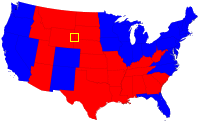
And the people we encountered along the way were elder-hostel types or locals. The few conversations we were in or heard were depressing. The McCain/Palin stickers were still on the cars, and most of the public tv’s were tuned to Fox News unless I changed them. I guess it wasn’t too different from the state of affairs here in the South.
When I look at the graphs on the right, what I see is a remarkable early recovery from a financial meltdown that I wasn’t sure we would recover from. And my reading of the proposed Health Care Reform is that it’s what we need. The Health Care Industry is killing us, and needs to be brought under control. Meanwhile, much of the country is without Medical coverage. When I got home, our cleaning lady was sick. She needs some lab work before treating her for what’s wrong, and she can’t get the lab work from the free clinic for a month, s o I sent her off to a private lab on my nickle. I don’t mind, but it’s not the way things ought to work.
o I sent her off to a private lab on my nickle. I don’t mind, but it’s not the way things ought to work.
CIA Documents Provide Little Cover for Cheney Claims
Documents Fail to Exonerate ‘Enhanced Interrogation’ Techniques
Washington Independent
By Spencer Ackerman
8/24/09
For months, former Vice President Dick Cheney has said that two documents prepared by the CIA, one from 2004 and the other from 2005, would refute critics of the Bush administration’s torture program. He told Fox’s Sean Hannity in April:
“I haven’t talked about it, but I know specifically of reports that I read, that I saw, that lay out what we learned through the interrogation process and what the consequences were for the country,” Cheney said. “I’ve now formally asked the CIA to take steps to declassify those memos so we can lay them out there and the American people have a chance to see what we obtained and what we learned and how good the intelligence was.”Those documents were obtained today by The Washington Independent and are available here. Strikingly, they provide little evidence for Cheney’s claims that the “enhanced interrogation” program run by the CIA provided valuable information. In fact, throughout both documents, many passages — though several are incomplete and circumstantial, actually suggest the opposite of Cheney’s contention: that non-abusive techniques actually helped elicit some of the most important information the documents cite in defending the value of the CIA’s interrogations.
The first document, issued by the CIA in July 2004 is about the interrogation of 9/11 architect Khalid Sheikh Mohammed, who was waterboarded 183 times in March 2003 and whom, the newly released CIA Inspector General report on torture details, had his children’s lives threatened by an interrogator. None of that abuse is referred to in the publicly released version of the July 2004 document. Instead, we learn from the July 2004 document that not only did the man known as “KSM” largely provide intelligence about “historical plots” pulled off from al-Qaeda, a fair amount of the knowledge he imparted to his interrogators came from his “rolodex” — that is, what intelligence experts call “pocket litter,” or the telling documentation found on someone’s person when captured. As well, traditional intelligence work appears to have done wonders — including a fair amount of blundering on Khalid Sheikh Mohammed’s part:
In response to questions about [al-Qaeda’s] efforts to acquire [weapons of mass destruction], [Khalid Sheikh Mohammed] revealed that he had met three individuals involved in [al-Qaeda’s] program to produce anthrax. He appears to have calculated, incorrectly, that we had this information already, given that one of the three — Yazid Sufaat — had been in foreign custody for several months.This is a far cry from torturing Khalid Sheikh Mohammed into revealing such information. It would be tendentious to believe that the torture didn’t have any impact on Khalid Sheikh Mohammed — he himself said that he lied to interrogators in order to get the torture to stop — but the document itself doesn’t attempt to present a case that the “enhanced interrogation” program was a factor, let alone the determinant factor, in the intelligence bounty the document says he provided.The second newly released document — a June 2005 overview of information extracted from detainees — is, if anything, more caveated. In making a case that “detainee reporting” was “pivotal for the war against [al-Qaeda],” it says that “detainee reporting is often incomplete or too general to lead directly to arrests; instead, detainees provide critical pieces to the puzzle, which, when combined with other reporting, have helped direct an investigation’s focus and led to the capture of terrorists.” Khalid Sheikh Mohammed is the prime example here.
The document also discusses unraveling the network of Indonesian al-Qaeda affiliate Hambali after Khalid Sheikh Mohammed’s capture. There are repeated references to the value of “debriefings,” which the 2004 CIA inspector general’s report says are distinct from the “enhanced interrogation techniques” but can be used after they occur. For instance, “Debriefings of mid-level [al-Qaeda] operatives also have reported on specific plots against U.S. interests.” Indeed, in a section titled “Aiding Our Understanding [al-Qaeda],” a listed example is:
Abu Zubaydah’s identification early in his detention of [Khalid Sheikh Mohammed] as the mastermind of 11 September and [al-Qaeda’s] premier terrorist planner and of ‘Abd al-Rahim al-Nashiri as another key [al-Qaeda] operational planner corroborated information [REDACTED].Those revelations, as former Abu Zubaydah interrogator Ali Soufan has testified, came before Abu Zubaydah was tortured.
Similarly, the document contains accounts of how interrogators performed the traditional interrogation labors of cross-checking detainees’ accounts with each other to determine veracity, and particularly when cross-referenced with “large volumes of documents and computer data”:
For example, lists of names found on the computer [REDACTED] — a key [al-Qaeda] financial operative and facilitator for the 11 September attacks — seized in March 2003 represented [al-Qaeda] members who were to receive funds. Debriefers questioned detainees extensively on the names to determine who they were and how important they were to the organization. The information [REDACTED] helped us to better understand al-Qa’ida’s hierarchy, revenues, and expenditures, [REDACTED] as well as funds that were available to families.Again, perhaps the blacked-out lines of the memos specifically claim and document that torture and only torture yielded this information. But what’s released within them does not remotely make that case. Cheney’s public account of these documents have conflated the difference between information acquired from detainees, which the documents present, and information acquired from detainees through the enhanced interrogation program, which they don’t.
In a statement, Tom Parker, the policy director of Amnesty International’s American branch, said, “Perhaps unsurprisingly, given Vice President Cheney’s track record, the two CIA memos released today are hardly the slam dunk we had been led to expect. There is little or no supporting evidence in either memo to give substance to the specific claims about impending attacks made by Khaled Shaik Mohammed in highly coercive circumstances.”
Some things are pretty remarkable for their irony. In 1992, it was discovered that some DoD manuals containing instructions about torture techniques that had been outlawed for a decade still existed. When they were found, they were ordered destroyed. That scribble on the "Approved" line is the initial of then Secretary of Defense Dick Cheney. And the note on the side is from the ever present, David Addington.